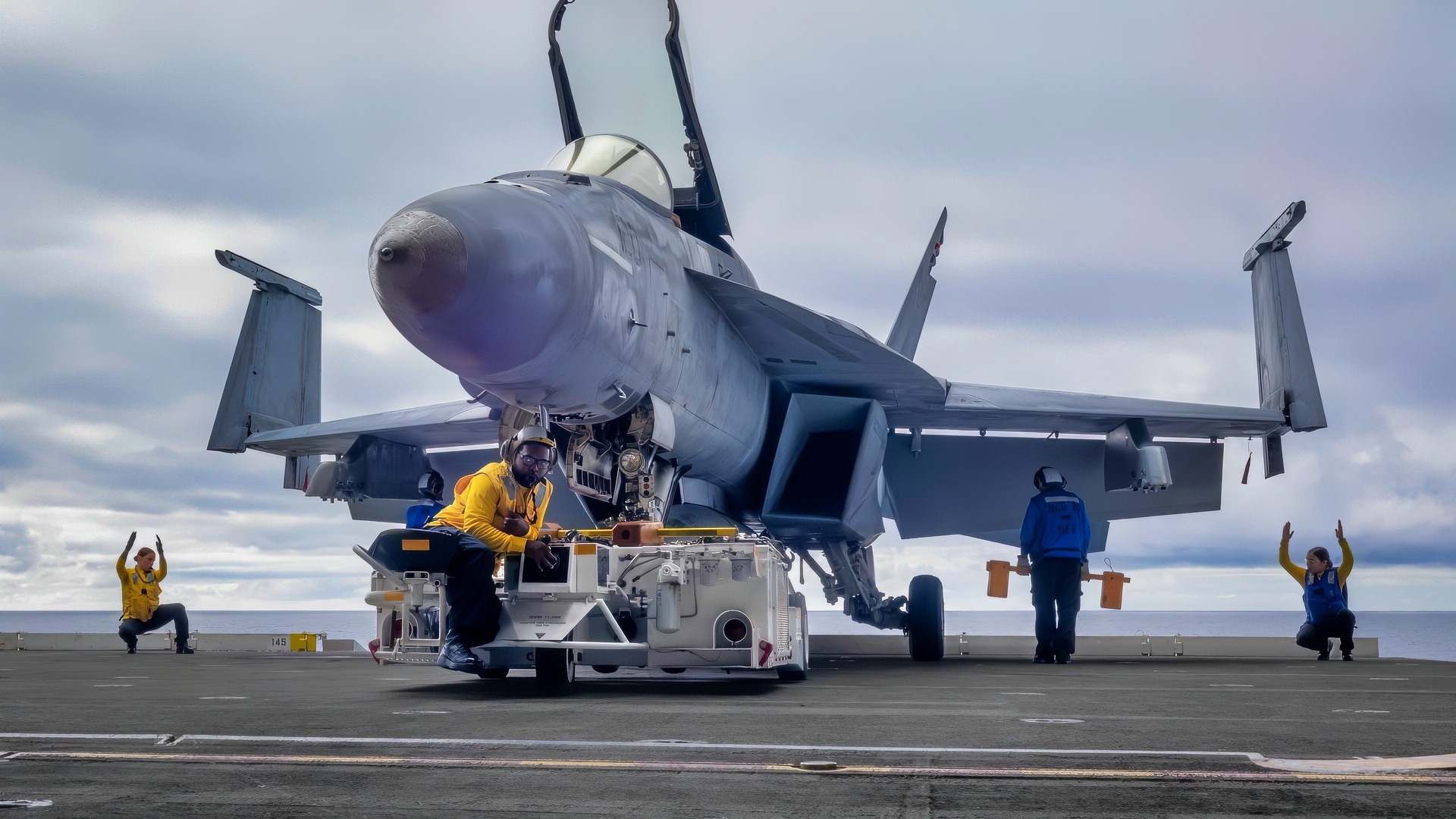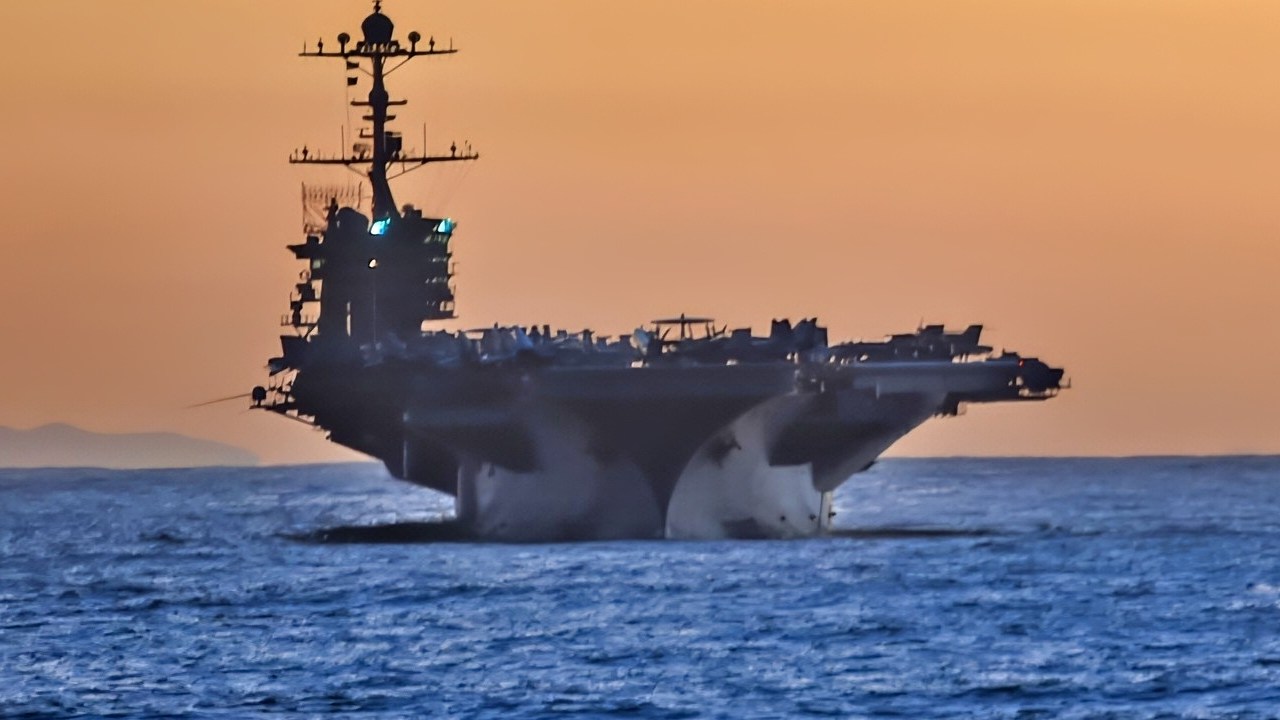Key Points and Summary – China’s DF-21D is the country’s original “carrier-killer,” a road-mobile, solid-fuel ballistic missile designed to hit moving U.S. aircraft carriers from 1,500-2,000 km away.
-Operational since around 2012, it uses a maneuverable reentry vehicle (MaRV) at speeds up to Mach 10, making interception extremely difficult.

ATLANTIC OCEAN (Aug. 13, 2025) Sailors transport an F/A-18E Super Hornet attached to the “Gladiators” of Strike Fighter Squadron (VFA) 106 onto an aircraft elevator aboard the Nimitz-class aircraft carrier USS George H.W. Bush (CVN 77). George H.W. Bush is underway conducting carrier qualifications and routine operations in the Atlantic Ocean. (U.S. Navy photo by Mass Communication Specialist Seaman Apprentice Kayleigh Tucker)
-As a cornerstone of China’s A2/AD strategy, it aims to create a “no-go zone” in a Taiwan conflict.
-However, its effectiveness is unproven in combat and relies on a complex “kill chain” of sensors that U.S. electronic warfare is designed to disrupt.
How China Would Sink a U.S. Navy Aircraft Carrier in a War: Meet the DF-21D
The DF-21D is the most recent variant of the DF-21 missile family, which was first introduced in the 1980s.
The original DF-21 was China’s first solid-fuel, road-mobile ballistic missile, entering service in the early 1990s.
The DF-21D, however, was introduced in the mid-2000s and declared operational around 2012.
Unlike its predecessors, the DF-21D is tailored for anti-ship missions, giving China a unique capability to threaten high-value naval assets from land-based platforms.
That One Word: DF-21D
The DF-21D has an estimated range of 1,500 to 2,000 kilometers, enabling it to cover critical maritime zones, including the South China Sea, the Taiwan Strait, and parts of the Philippine Sea.
It is launched from road-mobile transporter erector launchers (TELs), which enhance its survivability and mobility.
The missile carries a conventional high-explosive warhead, likely around 600 kilograms, designed to disable rather than sink a carrier. A direct hit could severely damage a carrier’s flight deck, radar systems, or propulsion, rendering it inoperable for extended periods.

Two F-35C Lightning II carrier variant joint strike fighters conduct the first catapult launches aboard the aircraft carrier USS Nimitz (CVN 68). The F-35 Lightning II Pax River Integrated Test Force from Air Test and Evaluation Squadron (VX) 23 is conducting initial at-sea trials aboard Nimitz. (U.S. Navy photo courtesy of Lockheed Martin by Dane Wiedmann/Released)
The DF-21D is believed to use highly sophisticated guidance systems to ensure pinpoint accuracy.
According to reports, it uses a combination of inertial navigation, terminal radar, and possibly optical sensors.
The missile is believed to be equipped with a maneuverable reentry vehicle (MaRV), which allows it to adjust its trajectory during the terminal phase of flight.
This capability is crucial for striking moving targets at sea, especially those as large and fast as aircraft carriers.
The missile’s terminal speed is estimated to reach Mach 10, making interception extremely difficult and night impossible for current missile defense systems.
China’s Original Carrier-Killer
Targeting a moving ship with a ballistic missile is a complex challenge, but China claims to have developed a sophisticated reconnaissance-strike complex to support the DF-21D.
This system includes over-the-horizon (OTH) radar, maritime surveillance satellites, unmanned aerial vehicles (UAVs), and data fusion networks. These assets work together to track U.S. carrier movements and relay targeting information to missile units, enabling mid-course updates and precise terminal guidance.
The DF-21D has become the cornerstone of China’s A2/AD strategy. Its primary purpose is to deter or delay U.S. military intervention in regional conflicts, particularly those involving Taiwan.
By threatening U.S. carrier strike groups (CSGs), the DF-21D raises the cost of intervention and limits the freedom of movement of American forces in contested waters.
This missile challenges the traditional dominance of U.S. naval power, forcing a reevaluation of deployment strategies and operational doctrines.

The aircraft carrier USS Nimitz (CVN 68) steams in the Pacific Ocean, Oct. 5, 2024. Nimitz is underway in 3rd Fleet conducting routine training operations. (U.S. Navy photo by Mass Communication Specialist Second Class Carson Croom)
What the DF-21D Means for the U.S. Navy
Aircraft carriers are some of the most critical assets in the U.S. Navy, capable of launching air strikes, conducting surveillance, and supporting amphibious operations.
The DF-21D undermines this capability by potentially neutralizing carriers before they can get close enough to be effective.
While they are unlikely to sink a carrier, one or two well-placed shots on the flight deck are likely to put an aircraft carrier out of action for a long while.
This has led to increased caution in carrier operations near China’s coast and a greater emphasis on countermeasures and alternative platforms.
While the DF-21D has not been used in combat, Chinese sources suggest that test launches against ship-like targets have been successful.
Analysts believe that even a single hit could cause catastrophic damage to a carrier, resulting in a mission kill.
The mere existence of the DF-21D forces U.S. planners to consider the risk of missile strikes in their operational decisions, potentially leading to more conservative deployments and greater reliance on submarines, long-range aircraft, and missile-armed escorts.
The DF-21D: Threat or Theatrics?
However, some experts have cautioned against taking China’s words at face value regarding the DF-21D.
There is no combat-proven record of the missile striking a moving carrier in sea conditions, and U.S. Navy commanders maintain confidence in their ability to operate in contested environments. Furthermore, we don’t know how the missile will perform in environments with heavy electronic warfare capabilities.
Most carriers and their supporting ships have comprehensive suites of EW systems that are designed to jam and disrupt incoming missiles.
The Pentagon and the U.S. Navy remain confident in their crews and defense systems to keep carriers operational, even under high-stress conditions.
In response to Chinese carrier-killers, U.S. carrier groups may be forced to operate farther from shore, relying on long-range aircraft and missile-armed escorts to maintain effectiveness while staying outside the DF-21D’s range.
This shift could alter the way the U.S. projects power in the Indo-Pacific, emphasizing flexibility, survivability, and integration across multiple domains.
However, even if the DF-21 does not live up to the myth China is trying to sell, it, along with China’s other missiles, still poses a considerable threat to the U.S. China’s impressive industrial capabilities further exacerbate this threat.
The exact number of missiles in China’s inventory is unknown.
Estimates range from 80 to 200 missiles currently in service.
The actual value of the DF-21D, and any missile for that matter, lies not in its accuracy and speed, but in its producibility.
About the Author: Isaac Seitz
Isaac Seitz, a Defense Columnist, graduated from Patrick Henry College’s Strategic Intelligence and National Security program. He has also studied Russian at Middlebury Language Schools and has worked as an intelligence Analyst in the private sector.
More Military
Forget the F-35 of F-47: A 7th Generation Fighter Is Possible
$500 Drones are Destroying $10,000,000 NATO Tanks in Ukraine War
The Mach 2.2 F-4 Phantom II Fighter Has a Message for Every Air Force on Earth
China’s White Emperor ‘NGAD’ Stealth Fighter Summed Up in 2 Words










